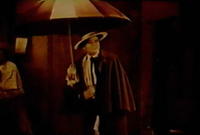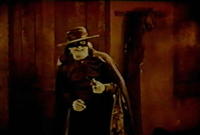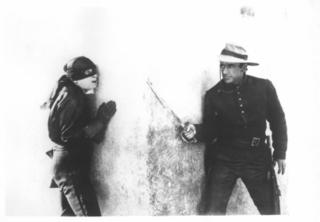 But before all these (indeed, anticipating them by twenty years) there was Zorro aka Don Diego de la Vega. As the Zorro Legend website points out, Johnston McCulley's character, part foppish aristocrat, part avenging swordsman, echoes the Baroness Orczy's Scarlet Pimpernel. In The Mark of Zorro, Douglas Fairbanks takes this literary doppelganger and makes of him what could well be Hollywood's first superhero.
But before all these (indeed, anticipating them by twenty years) there was Zorro aka Don Diego de la Vega. As the Zorro Legend website points out, Johnston McCulley's character, part foppish aristocrat, part avenging swordsman, echoes the Baroness Orczy's Scarlet Pimpernel. In The Mark of Zorro, Douglas Fairbanks takes this literary doppelganger and makes of him what could well be Hollywood's first superhero.(William Stoddard also has a good review and discussion of McCulley's book and the 1920 adaptation.)
 Zorro's remit, however, is more local and more clearly political than that of most later superheroes. He's not called in to save the world, but he does aim to change it. Lately returned from Spain to his native California, Don Diego is disgusted with the corruption of Spanish imperial power, a corruption manifest in mistreatment of Indians, of priests, and (what is worst of all) of the beautiful Señorita Lolita Pulido.
Zorro's remit, however, is more local and more clearly political than that of most later superheroes. He's not called in to save the world, but he does aim to change it. Lately returned from Spain to his native California, Don Diego is disgusted with the corruption of Spanish imperial power, a corruption manifest in mistreatment of Indians, of priests, and (what is worst of all) of the beautiful Señorita Lolita Pulido.Zorro's task is to rouse what has become a servile and languid creole aristocracy, and to goad them into ejecting the Spanish interloper from their shores.
Clearly, persuasion alone is not going to galvanize the Californian caballeros. Zorro aims to shame his fellows into action. The split between Don Diego, the fop rejected by the beauty Lolita, and Zorro, the dark knight who charms and impresses her with his hyper-masculine sword-thrusts, enacts the sexualized psychodrama of a quiescent upper class being beaten to the prize by new, mobile men of action. The lesson to be learned is immediately affective: the creole class lacks intensity; but shame could lead to revivified pride, and so to political significance at last.
The two aspects to Fairbanks's character are therefore less different psychologically than they incarnate differing states of the body: tiredness vs. wakefulness; langour vs. vigilance; passivity vs. activity; quiescence vs. tumescence. And the film as a whole is a film of the transition, of the individual but also the collective shift from sedentariness to motility.
Fairbanks's stunts (most of which he performed himself) are always exaggeratedly physical: his body describes ever more impressive arcs and leaps, jumping on to and over horses, over wagons and up walls. His characteristic movement is something like a sideways combined twist and turn and spring from a standing start.
At the same time, Zorro knows when to keep still. A favoured trick is to hide behind a bush, a door, or a wall, while a horde of pursuers blunder blindly past. It is not therefore movement per se that is valorized: it is the right combination of movement and rest. Zorro's stillness is taught with the alert possibility of sudden movement at any moment. His body is a spring coiled and ready to leap. It is the instant of contraction before an explosive power is unleashed.

Just a couple of decades after the US had dispossessed Spain of its last imperial possessions (Cuba, Puerto Rico, and the Philippines), and a couple of years after Europe had been suicidally bogged down in the First World War trenches, surely Zorro could also be seen as the image of US power ready to unfold. And his warning to Don Diego seen as a caution against the country's resting on its new-found laurels. Fairbanks's Zorro marks America's transition as it becomes superpower.
(Crossposted from Latin America on Screen.)
No comments:
Post a Comment